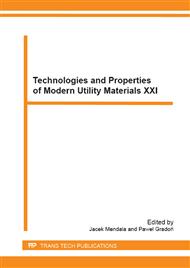p.91
p.95
p.101
p.107
p.111
p.115
p.121
p.127
p.133
Influence of the Ion Nitriding Process on the Electrochemical Properties of X39Cr13 Steel Used for Surgical Instruments
Abstract:
The main aim of this work was to determine the effect of nitriding process on the electrochemical properties of martensitic steel X39Cr13 used for surgical instruments treatments. The research was conducted on the samples of diameter d = 14 mm made of X39Cr13 martensitic steel in the annealed condition. The samples were subjected to heat-treatment: hardening and tempering processes. The way of surface preparation of the samples contained mechanical processing: barrel finishing, chemical passivation and nitriding using fluorescent methods. The nitriding process was carried out in an apparatus for machining a cooled anode glow type JON-600. Nitriding process was carried out at a temperature T = 470 °C. To evaluate the electrochemical properties the pitting corrosion resistance were studied. The corrosion resistance tests of samples were carried out by means of potentiodynamic method (registering anodic polarization curves). The measurements were conducted in physiological Tyrodes solution. On the basis of the results it was affirmed diverse corrosion resistance of the samples for different variants of the surface preparation. The highest corrosion resistance was observed for the barrel finished and nitriding process of the samples. The research revealed that the suggested variants of surface treatment influence the corrosion resistance of the X39Cr13 steel intended for surgical tools.
Info:
Periodical:
Pages:
111-114
Citation:
Online since:
December 2013
Authors:
Keywords:
Price:
Сopyright:
© 2014 Trans Tech Publications Ltd. All Rights Reserved
Share:
Citation:


